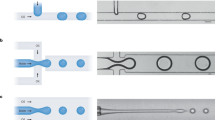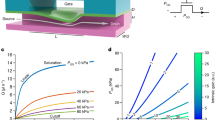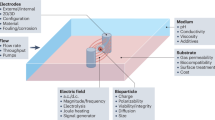Abstract
Microfluidic chip platforms for manipulating liquid volumes in the nanoliter range are slowly inching their way into mainstream genomic and proteomic research. The principal challenge faced by these technologies is the need for high-throughput processing of increasingly smaller volumes, with ever higher degrees of parallelization. Significant advances have been made over the past few years in addressing these needs through electrokinetic manipulation, vesicle encapsulation and mechanical valve approaches. These strategies allow levels of integration density and platform complexity that promise to make them into serious alternatives to current robotic systems.
This is a preview of subscription content, access via your institution
Access options
Access to this article via ICE Institution of Civil Engineers is not available.
Subscribe to this journal
Receive 12 print issues and online access
$209.00 per year
only $17.42 per issue
Buy this article
- Purchase on SpringerLink
- Instant access to full article PDF
Prices may be subject to local taxes which are calculated during checkout




Similar content being viewed by others
References
Manz, A. et al. Planar chips technology for miniaturization and integration of separation techniques into monitoring systems: capillary electrophoresis on a chip. J. Chromatogr. 593, 253–258 (1992).
Reyes, D.R., Iossifidis, D., Auroux, P.A. & Manz, A. Micro total analysis systems. 1. Introduction, theory, and technology. Anal. Chem. 74, 2623–2636 (2002).
Auroux, P.A., Iossifidis, D., Reyes, D.R. & Manz, A. Micro total analysis systems. 2. Analytical standard operations and applications. Anal. Chem. 74, 2637–2652 (2002).
Khandurina, J. & Guttman, A. Bioanalysis in microfluidic devices. J. Chromatogr. A 943, 159–183 (2002).
Quake, S.R. & Scherer, A. From micro- to nanofabrication with soft materials. Science 290, 1536–1540 (2000).
Hansen, C.L. & Quake, S.R. Microfluidics in structural biology: smaller, faster... better. Curr. Opin. Struct. Biol. in the press (2003).
Madou, M.J. Fundamentals of Microfabrication: The Science of Miniaturization. edn 2 (CRC Press, Boca Raton, Florida, 2002).
Yuen, P.K. et al. Microchip module for blood sample preparation and nucleic acid amplification reactions. Genome Res. 11, 405–412 (2001).
Anderson, R.C., Su, X., Bogdan, G.J. & Fenton, J. A miniature integrated device for automated multistep genetic assays. Nucleic Acids Res. 28, E60 (2000).
Moorthy, J. & Beebe, D. Organic and biomimetic designs for microfluidic systems. Anal. Chem. 75, 293A–301A (2003).
Emrich, C.A., Tian, H., Medintz, I.L. & Mathies, R.A. Microfabricated 384-lane capillary array electrophoresis bioanalyzer for ultrahigh-throughput genetic analysis. Anal. Chem. 74, 5076–5083 (2002).
Kuo, T.-C., Cannon, D.M. Jr., Shannon, M.A., Bohn, P.W. & Sweedler, J.V. Hybrid three-dimensional nanofluidic/microfluidic devices using molecular gates. Sens. Actuators A 102, 223–233 (2003).
Burns, M.A. et al. An integrated nanoliter DNA analysis device. Science 282, 484–487 (1998).
Thorsen, T., Roberts, R.W., Arnold, F.H. & Quake, S.R. Dynamic pattern formation in a vesicle-generating microfluidic device. Phys. Rev. Lett. 86, 4163–4166 (2001).
Anna, S., Bontoux, N. & Stone, H. Formation of dispersions using “flow focusing” in microchannels. Appl. Phys Lett. 82, 364–366 (2003).
Song, H., Tice, J.D. & Ismagilov, R.F. A microfluidic system for controlling reaction networks in time. Angew. Chem. Int. Ed. 42, 768–772 (2003).
Karlsson, A. et al. Nanofluidic networks based on surfactant membrane technology. Anal. Chem. 75, 2529–2537 (2003).
Thorsen, T., Maerkl, S.J. & Quake, S.R. Microfluidic large-scale integration. Science 298, 580–584 (2002).
Jacobson, S.C. & Ramsey, J.M. Anal. Chem. 68, 720–723 (1996).
Broyles, B.S., Jacobson, S.C. & Ramsey, J.M. Sample filtration, concentration, and separation integrated on microfluidic devices. Anal. Chem. 75, 2761–2767 (2003).
Tang, T. et al. Integrated microfluidic electrophoresis system for analysis of genetic materials using signal amplification methods. Anal. Chem. 74, 725–733 (2002).
Ramsey, J.M. et al. Anal. Chem. AC0346510, in the press (2003).
Hansen, C.L., Skordalakes, E., Berger, J.M. & Quake, S.R. A robust and scalable microfluidic metering method that allows protein crystal growth by free interface diffusion. Proc. Natl. Acad. Sci. USA 99, 16531–16536 (2002).
Liu, J., Hansen, C.L. & Quake, S.R. Solving the world-to-chip interface problem with a microfluidic matrix. Anal. Chem. in the press (2003).
Jeon, N. et al. Neutrophil chemotaxis in linear and complex gradients of interleukin-8 formed in a microfabricated device. Nat. Biotechnol. 20, 826–836 (2002).
Pollack, L. et al. Time-resolved collapse of a folding protein observed with small angle X-ray scattering. Phys. Rev. Lett. 86, 4962–4965 (2001).
Acknowledgements
The authors would like to thank the various members of the Quake group, past and present, for many stimulating discussions.
Author information
Authors and Affiliations
Corresponding author
Rights and permissions
About this article
Cite this article
Hong, J., Quake, S. Integrated nanoliter systems. Nat Biotechnol 21, 1179–1183 (2003). https://doi.org/10.1038/nbt871
Published:
Issue Date:
DOI: https://doi.org/10.1038/nbt871



